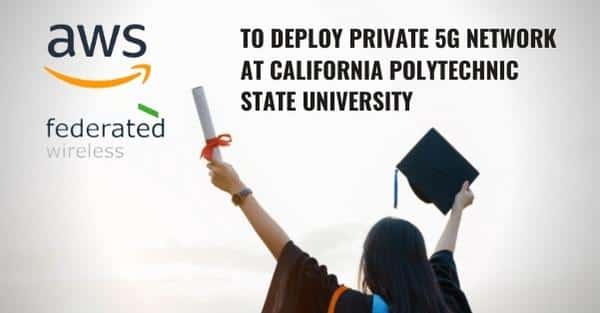Federated Wireless announced it is working with Amazon Web Services (AWS) on a private wireless deployment with California Polytechnic State University (Cal Poly) to support the university’s 5G innovation network. The deployment will increase research capabilities, enhance bandwidth and advance connectivity across the San Luis Obispo, California, campus. Cal Poly is one of the nation’s top masters-level public universities and a leader in digital transformation.
The Cal Poly deployment is part of a broader initiative between Federated Wireless and AWS to build, deploy and manage private wireless networks, and accelerate digital transformation for customers across industries. Sold as a managed service to customers in AWS Marketplace, the Federated Wireless Private Wireless Network for Your Enterprise offers a turnkey private wireless solution with all the advantages of private wireless combined with rapid deployment, skilled resources, assured service management, and support. The combination of edge services on AWS, and Federated Wireless managed services enables a private wireless network to be deployed and operational in a matter of weeks.
The Cal Poly Digital Transformation Hub (DxHub), powered by AWS, is a Cloud Innovation Center that solves real-world challenges, further accelerating the adoption of technologies such as cloud, edge, and Internet of Things (IoT) for public sector organizations. With the launch of Cal Poly’s 5G innovation network, the university can leverage the cloud-based advantages of shared-spectrum-enabled CBRS 5G connectivity to advance cutting-edge projects and research. Faculty and students across disciplines are currently working on a construction management project to pilot the use of a digital twin for the campus. Other research opportunities include smart greenhouses, autonomous farming, and various data-intensive projects.
“Cal Poly continues to lead in the development of a digital campus. We’re driving innovation for smart buildings and smart agriculture by introducing new devices and applications, and now we have a more reliable way to get data from point A to point B. Federated Wireless and AWS are giving us the 5G backbone to make the digital campus a reality,” said Bill Britton, Cal Poly’s vice president for information technology services and chief information officer. “Our work is all about Learn by Doing, ensuring students, faculty, and staff have access to the latest technology to advance research and innovation. Federated Wireless and AWS are enabling us to bring the power and privacy of 5G to our campus faster.”
The unique multi-tenancy capabilities of private wireless ensure the solution can partition private network resources for different requirements and user groups. This means the private 5G resources can scale to accommodate projects starting with the DxHub as well as various organizations on campus, including IT services, facilities, and academic research.
Built on AWS Snowcone, an ultra-portable and rugged edge compute, storage, and data transfer device, and connected over Federated Wireless shared spectrum deployed on AWS, the 5G private wireless solution is designed to deliver secure, reliable connectivity in highly remote environments where last-mile connectivity has traditionally been the greatest barrier to deploying innovative new applications and devices. Running on AWS allows Cal Poly to deliver cloud-based applications across its expansive and geographically diverse campus locations.
“It’s become very clear that private wireless is a major piece of the puzzle for enterprises to realize the massive potential of IoT and cloud automation,” said Iyad Tarazi, CEO of Federated Wireless. “Our work with AWS is about giving customers the easiest path to get started with private wireless while creating seamless, supported integrations. We’re proud to streamline this offering for entities that are eager to get started with private wireless and 5G.”
Federated Wireless is part of the AWS Independent Software Vendor (ISV) Accelerate Program, a co-sell program for AWS Partners who provide software solutions that run on or integrate with AWS. The program helps drive new business and accelerate sales cycles by connecting the participating ISVs with the AWS Sales organization.
“Our customers want simple, fast, and dedicated wireless connectivity to enable their mission-critical applications,” said Sameer Vuyyuru, head of worldwide business development, telco industry at AWS. “The combination of AWS with Federated Wireless’s Private Wireless Network for Your Enterprise helps simplify the process to build, deploy and manage private wireless networks, making it easier for more customers to realize the benefits. We are pleased to work with Cal Poly to leverage these benefits to accelerate learning and innovation across its campus.”





















